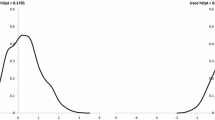Abstract.
The time distance methodology used offers a new perspective to the problem, an additional statistical measure, and a presentation tool for policy analysis and debate readily understood by policy makers, media and general public. Disparity between the analysed transition economies and EU countries is considerably smaller for other indicators than for GDP per capita. Compared with Ireland, Portugal and Greece Slovenia was in 1995 in 13 cases behind (but time lag of Slovenia never exceeded 10 years) and in 13 cases ahead of them. Sicherl (1997a) discusses application of S-distance to time series regressions, models, forecasting and monitoring.
Similar content being viewed by others
Author information
Authors and Affiliations
Additional information
First version received: October 1995/final version received: April 1998
Rights and permissions
About this article
Cite this article
Sicherl, P. Distance in time between transition economies and the European Union. Empirical Economics 24, 101–119 (1999). https://doi.org/10.1007/s001810050046
Issue Date:
DOI: https://doi.org/10.1007/s001810050046




